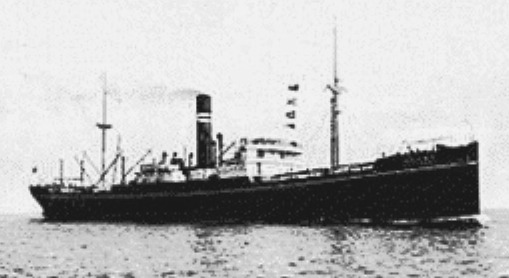RIKUGUN YUSOSEN
 (HAVRE MARU, prewar)
(HAVRE MARU, prewar)
IJA HAVRE MARU:
Tabular Record of Movement
© 2016 Bob Hackett
10 November 1919:
Tsurumi. Laid down at Asano Zosensho K.K., as yard No. 23, a 5,467-ton passenger-cargo ship for Kokusai Kisen, K.K., Tokyo.
1 May 1920:
Launched and named HAVRE MARU.
25 May 1920:
Completed.
28 November 1934:
Sold to Ishihara Sangyo Kaiun (later restyled as Ishihara Kisen) K. K. Registered at the port of Fuchu.
7 September 1941:
Requisitioned by the Imperial Army (IJA) as a troop transport. Alloted IJA No. 606.
24 April 1943:
Relased back to her owners and becomes a Haitosen - Army/Civilian (A/C-AK) shared employment ship. Assigned IJA No. 5098.
15 August 1944:
At 0550, HAVRE MARU departs Manila in convoy H-33 (stage 1) also consisting of CHINEZI, HACHIJIN, IWASHIRO, KOKUZAN, MISAKI, MEXICO, OLYMPIA and TOYO MARUs
17 August 1944:
Arrives at Cebu.
18 August 1944:
At 1830, HAVRE MARU departs Cebu in convoy H-33 (stage 2) also consisting of HACHIJIN, KOKUZAN and MEXICO, MARUs escorted by patrol boat P-105, minesweeper W-28 and subchaser CH-46.
21 August 1944:
Arrives at Zamboanga, Mindanao. At 0850 (JST), HAVRE MARU departs Zamboanga for Jolo, P.I. in convoy H-33 (stage 3) also consisting of MEXICO MARU escorted by patrol boat P-105, minesweeper W-28 and subchasers CH-31 and CH-46. HAVRE MARU is carrying the 374th Independent Infantry Battalion to join the 57th Independent Mixed Brigade.
HAVRE and MEXICO MARU anchor overnight at Jolo Anchorage.
22 August 1944:
At 0525 (JST) convoy H-33 weighs anchor and set a southern course to Tolitoli, north coast of Celebes.
23 August 1944:
70 nautical miles SSE of Jolo island. At 0005 (JST), HAVRE MARU, suddenly suffers a bent propeller shaft and becomes unnavigable at 04-42N, 121-42E. MEXICO MARU attempts to take HAVRE MARU in tow, but the towing line breaks.
24 August 1944:
Therafter, HAVRE MARU is taken in tow by PB-105 and towed back to Jolo Anchorage at 5 knots, escorted by CH-31. At 1045 (JST), arrives at Jolo. During the next weeks, she undergoes make-shift repairs, hampered by limited local resources. It is unclear if the bent shaft is repaired at Jolo. It appears HAVRE MARU was at anchor when driven aground by a heavy rain storm on a sand bar 2,000 meters NE of Jolo Town at 06-03N, 120-59E. Despite the combined efforts of Army and Navy personnel, the ship cannot be refloated.
29 August 1944:
At 0225, LtCdr (later Captain) Arthur E. Krapf's (USNA ’34) USS JACK (SS-259) torpedoes and sinks MEXICO MARU at 02-15N 122-29E. The ship is carrying 4,041 communications troops of the 26th Regiment and reserve troops and 1,000 tons of coal, 3,246 tons of general goods, 1,600 tons of rice, 1,000 cans of heavy oil or concentrated sulphuric acid, 103 cans of gasoline, 200 tons of coal, 8 tons of yellow gunpowder, 1,000 tons of clothing and 19 motor vehicles. 825 troops, a gunner and 21 crewmen are KIA. Krapf launches a second attack and sinks minesweeper W-28.
19 October 1944:
At 1000 (JST), HAVRE MARU undergoes an air attack at her grounding place. One plane drops two bombs, but there is no loss among the ship’s personnel or damage to engines.
30 October 1944:
HAVRE MARU suffers a heavy air attack which causes serious damages and the decision to abandon ship as a constructive total loss.
12 February 1945:
USAAF reconnaissance reports HAVRE MARU beached WNW of Jolo Island at 06-03N, 120-59E with her bridge structure completely demolished.
Authors' Note:
[1] Not to be confused with HAVRE MARU (5,652-ton), IJA No. 130.
Thanks go to Erich Muehlthaler of Germany.
Bob Hackett
Back
to IJA Transports





